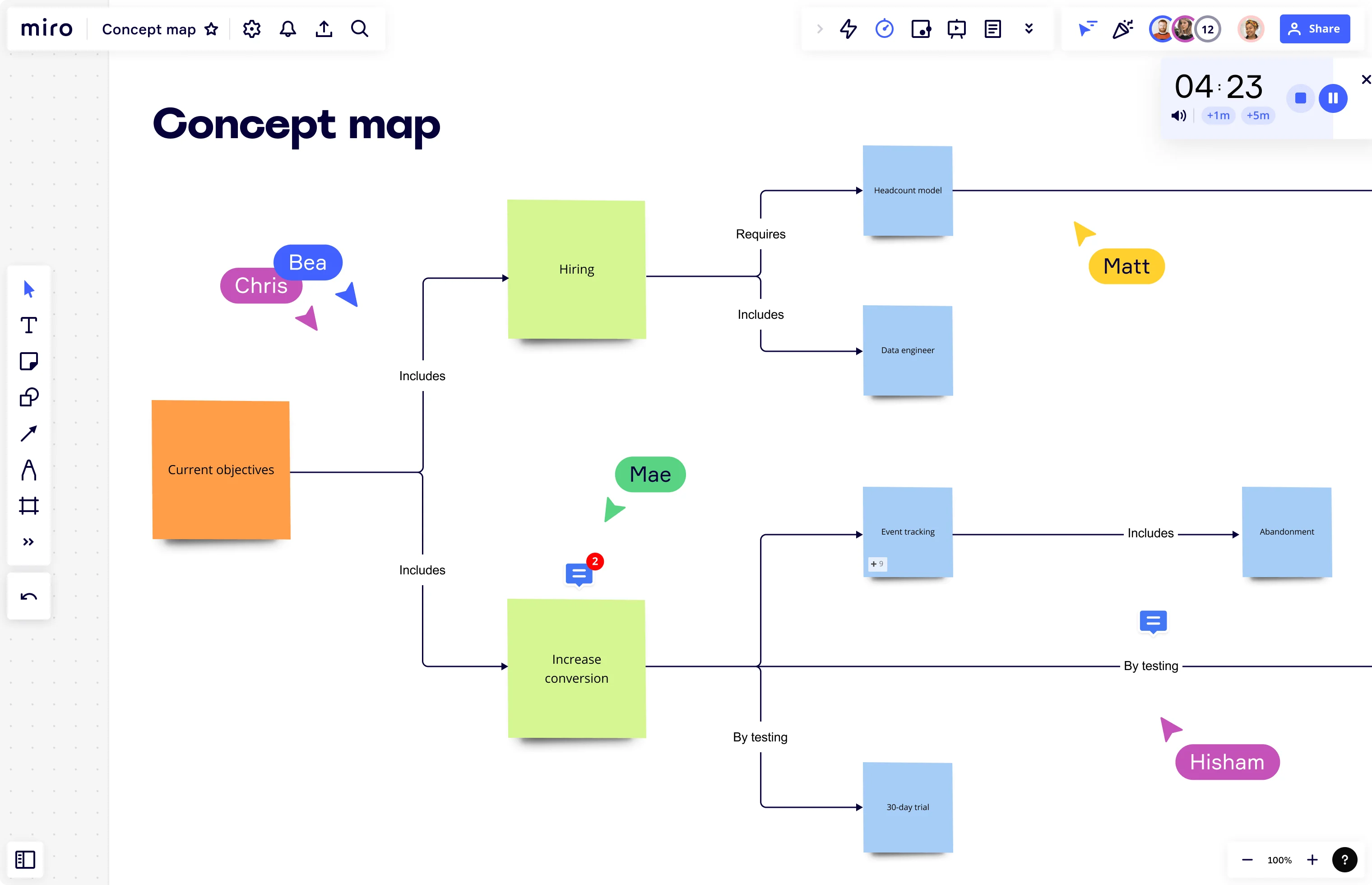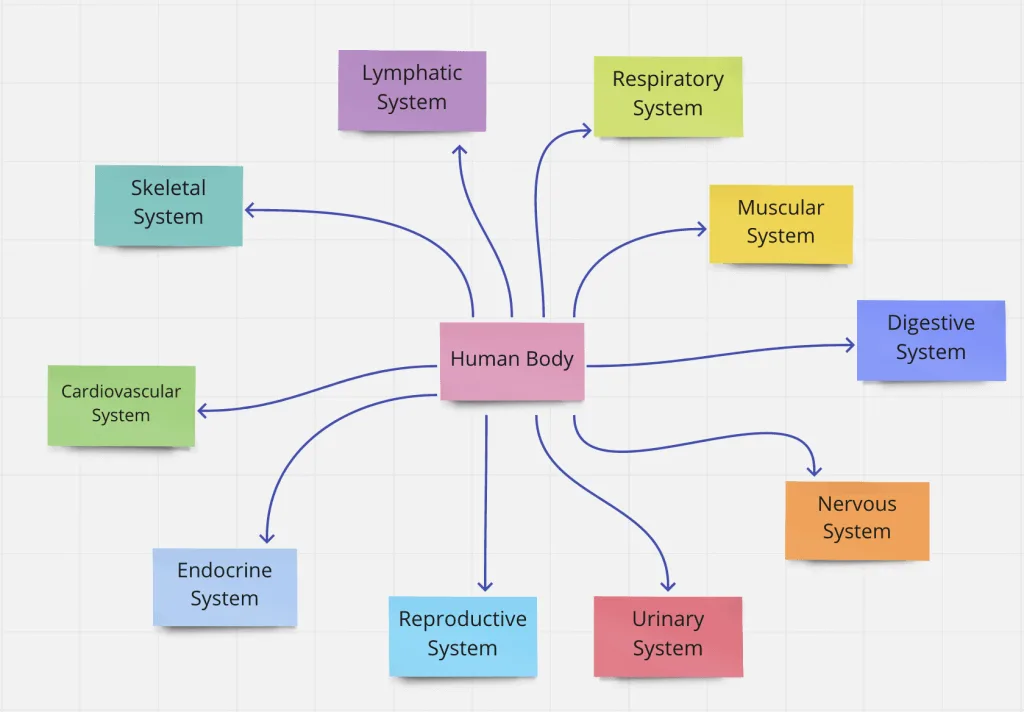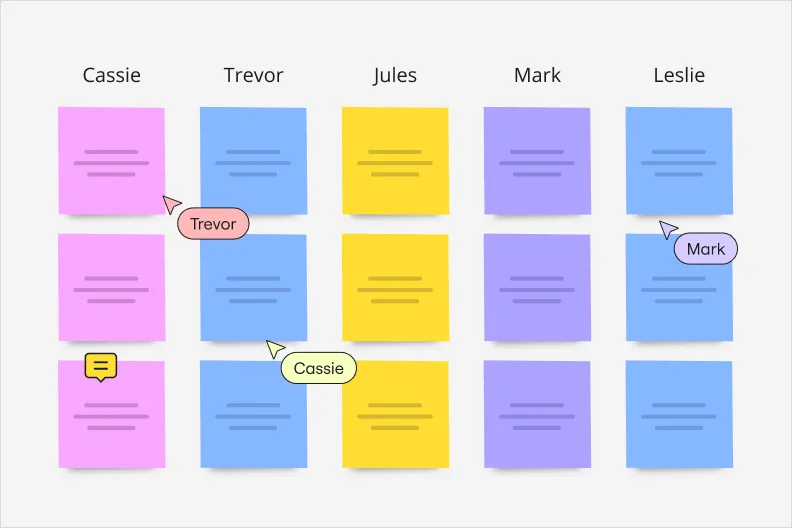Fikirleri bir konsept haritasıyla birbirlerine bağlayın

Hazır konsept haritası şablonu
Miro'nun basit ama güçlü Konsept Haritası Şablonuyla en karmaşık konseptleri görselleştirin ve netleştirin.

Sadece bir konsept haritası oluşturucu değil
Miro'nun konsept haritası oluşturucusu ekiplerin yeni fikirler üretmesine, bilgiyi organize etmesine ve karmaşık konseptlerin birbirleriyle bağlantılarını görselleştirmesine yardımcı olur. Birkaç tıklamayla çabucak bir konsept haritası oluşturun ve hiçbir şeyin anlamının kaybolmadığından emin olun.

Her an işbirliği yapın
Kişiyi vurgulayarak yorum yapma, entegre sohbet aracı, görüntülü sohbet ve diğer pek çok iletişim seçeneğiyle ekip üyelerinizi ve paydaşları geri bildirim vermeye, değerlendirme yapmaya ve onaylarını vermeye davet edin.

Miro neden konsept haritası oluşturmak için ideal araçtır
Sunum modu
Görsel konsept haritasının yardımıyla ekibinize fikirlerinizi açıklamak için sunum moduna geçin.
Yaratıcı biçimlendirme seçenekleri
Okuması kolay ve etkileşim kurması eğlenceli konsept haritaları oluşturmak için rengarenk yapışkan notlar ve emojiler kullanın.
Favori araçlarınız ile entegrasyonlar
Konsept haritalarınıza bağlam eklemek için Jira, InVision, Sketch, Google Drive ve diğer araçlarla entegrasyonun avantajlarından yararlanın.
Sonsuz tuval
Yapışkan notlar, belgeler ve daha fazla destekleyici içeriği tek bir panoya ekleyerek konsept haritanızı geliştirin.






Miro ile konsept haritası nasıl oluşturulur


Dünyanın en yenilikçi şirketlerinin her gün daha iyi işbirliği yapmasına yardımcı oluyoruz
"Miro ile proje brief'inden pazarda lansmana 10 ayda ulaştık. PepsiCo'da bu genellikle 3 yıl alır.”
Caroline de Diego
Kıdemli Yönetici, Global Tasarım ve Pazarlama İnovasyonu, PepsiCo

"Herkesin Miro'da birlikte planlama yapmak için bir araya gelmesi, en etkili girişimlerin doğru zamanda hayata geçirilmesini sağlıyor."
Lucy Starling
Ürün Operasyonları Lideri, Asos

"Ekip atölye çalışmalarında Miro kullanmaya 10 dakikada başladı. Kuruluşumuzu bu ürünü benimsemeye ikna etmek çok kolay oldu.”
Konrad Grzegory
Çevik Dönüşüm Lideri, CD PROJEKT RED

"Miro şablonları sıfırdan başlayarak aktiviteleri, fikirleri ve bağımlılıkları haritaladığımız tam kapsamlı bir plan hazırlamamıza yardımcı oldu."
Marc Zukerman
Proje Yönetimi Kıdemli Direktörü, Hearst

"Miro, tüm ekiplerimizin belirli araç ve modellerle uyum sağlamasına olanak tanıyor: bağımsız çalışıyorlar ve müşterilerimizin ihtiyaçlarını gerçekten karşılayan ürünler yaratıyorlar."
Luke Pittar
Sürdürülebilirlik İnovasyon ve Tasarım Koçu, The Warehouse Group

“Gerçekten yenilikçi olmak için herkesin sesinin duyulması ve herkesin diğerlerinin fikirlerinin üzerine koyarak geliştirmesi gerekiyor. Miro bunun bizim için mümkün olmasını sağladı.”
Brian Chiccotelli
Öğrenme Deneyimi Tasarımcısı, HP

Konsept haritası oluşturucu SSS
Konsept haritası oluşturmak için en iyi program hangisidir?
Konsept haritası oluşturucu seçerken arayüzün kullanım kolaylığı, konsept haritanızın görünüşü ve hissi ve elbette diğerlerini işbirliği için davet etmenin kolay olup olmadığı değerlendirilmelidir. Miro'nun konsept haritası oluşturucusu, konsept haritalarını oluşturmanıza ve organize etmenize yardımcı olan otomatik dal oluşturucu ve kapsamlı Şablon Kitaplığı gibi araçlar ve özellikler içeren bir araç seti sunar. Görsel işbirliği platformumuzu, herkesin gerçek zamanlı olarak veya farklı zamanlarda çalışmasını kolaylaştıracak şekilde tasarladık.
Miro'nun konsept haritası oluşturucusu ücretsiz mi?
Evet, %100 ücretsizdir ve kredi kartı gerektirmez. Miro'ya kaydolduktan sonra, şablon seçiciden Konsept Haritası Şablonu ekleyebilir, istediğiniz kadar ekip üyesini ücretsiz olarak davet edebilir ve işbirliği yapmaya başlayabilirsiniz.
Konsept haritası ne için kullanılır?
Konsept haritası karmaşık fikirler ve konseptleri görselleştirmek ve aralarındaki bağlantıları ortaya çıkarmak için kullanılan bir araçtır. Stratejiniz, planınız ve projenizin eksik noktalarını bağlamak için Miro'nun ücretsiz konsept haritası oluşturucusunu kullanın. Konsept haritasıyla, karmaşık bilgileri hiyerarşik bir düzende organize etmek kolaydır ve bir projenin veya stratejinin hangi yönde ilerlemesi gerektiği konusunda netlik ve kullanışlı bilgi sağlar.
Konsept haritası oluşturucu kullanmanın avantajları nelerdir?
Konsept haritası kullanmanın bir faydası da belirli bir konuya derinlemesine dalmayı sağlamasıdır. Konsept haritaları düşüncelerinizi organize etmenize, bilgiyi hatırlamanıza ve en önemlisi de konseptler arasındaki bağlantıları anlamanıza olanak tanır.




